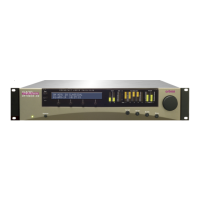2-38
INSTALLATION ORBAN MODEL 9400
yond the performance limitations of your transmitter. Doing so would
only cause distortion beyond the distortion intrinsic to asymmetrical op-
eration.
H) Navigate to SETUP > I/O CALIB /
I) Press the button corresponding to the active output.
J) Observe the oscilloscope. Adjust the output level control (AO1 100%, AO2
100%, DO1 100%, or DO2 100%) to achieve as high negative peak modula-
tion as possible without carrier pinch-off.
If all is well, the negative peaks of the envelope modulation will usually
hang close to 100% at all times except during pauses. If the correct ad-
justment of the output level control seems dependent on the nature of
the program material, the transmitter probably suffers from power sup-
ply bounce. See the next step.
To achieve highest possible modulation without carrier pinch-off (and
therefore most efficient utilization of available transmitter power), the
output level control must be adjusted with program material (not test
tones), because the transmitter will almost always behave somewhat dif-
ferently with program material than with tone. For example, tone cannot
excite power supply bounce.
K) Adjust the L+R LF GN control. (optional)
Some transmitters cannot be corrected fully because the bass boost pro-
duced by the equalizer exaggerates power supply bounce problems
and/or causes actual saturation or clipping of modulator stages, trans-
formers, reactors, etc. (see page 1-15). In some cases, a compromise be-
tween full tilt correction and these other problems may have to be
achieved by careful experimentation with program material. The 9400's
L+R LF GN control is designed to permit such a compromise.
The preceding transmitter equalization adjustment (using square waves)
was done using the maximum low-frequency boost to ensure response
that is closest to true DC coupling, which optimizes square wave re-
sponse. If this large amount of boost at sub-audible frequencies causes
bounce and/or distortion on heavy bass transients in music, turn the L+R
LF GN control down until these problems are no longer observed. This
will make the measured square wave response poorer. However, engi-
neering realities force a compromise between best small signal (i.e.,
square wave) response and best large signal (i.e., bounce and distortion)
performance. This compromise is best made by careful experimentation
with program material to find the setting of the L+R LF GN control that
gives the highest average modulation without audible distortion.
If the tilt correction trips overload relays when program material is
broadcast, it is often possible to readjust the trip point of these relays to
avoid this problem but do this with the greatest care, because the trans-
mitter will be endangered by an improperly adjusted overload relay.
Orban accepts no responsibility for transmitter failures introduced by
such re-adjustments, or by the high average power, bass and treble pre-
emphasis, or by any other characteristics of OPTIMOD-AM audio process-
ing.
The care and feeding of your transmitter requires the application of
sound engineering judgment: inadequate transmitters (typically of old

